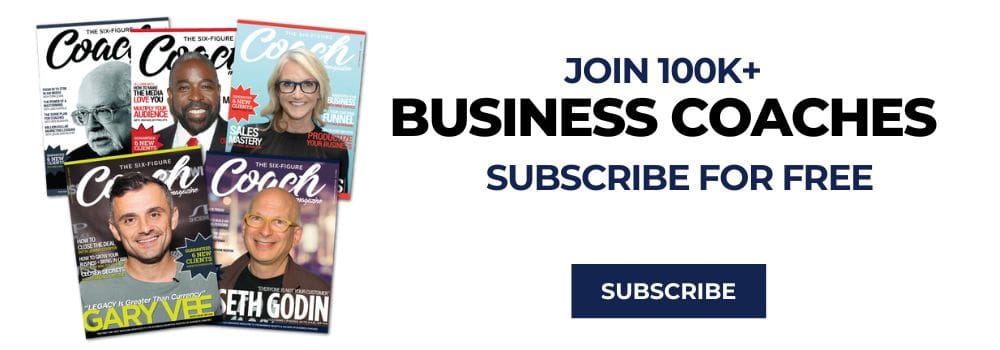Marketing Case Study Part 5 by Adrian Ulsh
Over my last several issues, I’ve been backing up a very bold statement I made.
I said that everything you’ve ever learned about generating leads and growing your coaching practice is WRONG.
Everything you’ve ever heard, everything you’ve ever tried, and everything you’ve ever done — it’s all WRONG.
In this multi-part series, I want to teach you a system for marketing your coaching, to a point where it becomes instantly obvious to your prospects that they would be an idiot to receive coaching from anyone other than you, at any time, anywhere or at any price.
In my last article, I discussed three concepts that no one else in the world of marketing understands, but three concepts that will make all the difference in the world in your marketing’s effectiveness and, more importantly, in your business’s profitability.
Those three concepts were downtime, uptime, and the reticular activation system, also known as the reticular activator. Please review part 4 again so you have a thorough understanding of these three critical concepts. Today, I’ll explain in-depth how you as a business coach can use hot buttons to generate dramatic increases in your client’s leads and conversion rates.
Hot buttons
Hot buttons are important, relevant issues. If you’re a golf fan and your reticular activator detects that Tiger Woods is on the television, it notices that on a conscious level because Tiger Woods is familiar. He’s an activator. Then your brain immediately asks, “Hey, what’s Tiger Woods doing driving a Buick? Is there anything here that’s relevant or important to me?” Or in other words, is this a hot button issue for me at this point in my life?
What typically happens is your brain determines that Buick is not important or relevant to you… it doesn’t do anything to solve any of your problems… and therefore it’s not a hot button. And so, your brain immediately reverts back into downtime. Let me be crystal clear here.
An activator is something that snaps a person from downtime to uptime… and it’s based on something that’s familiar, unusual, or problematic. But an activator can also be classified as a hot button if — and only if — it’s based on something that’s important and relevant to your prospect.
Your best bet to successfully interrupt and engage your target market is to identify problems, frustrations, uncertainties, and annoyances your prospects have… and then address them in your marketing. Their pain in most cases is their hot button. And please don’t think this is some form of manipulation. All we’re doing here is tapping into the problems that your prospects already have.
We’re not trying to manufacture a crisis for them. We’re merely poking their problems… and pointing out those problems… so that their reticular activator notices and brings us onto their active radar screen. Now, here’s the key point in all of this, and one that none of the big ad agencies understand, but one that you need to know in order to make this all work for you.
Activators
The activators that are used to interrupt the prospect must be based on a relevant hot button. If not, the prospect will momentarily be interrupted… but will quickly revert from uptime back into downtime. This is what we call “false uptime.”
Have you ever heard someone call out your name in a crowded room? That immediately interrupts you because your name is familiar. But when you turn around to see who it was that was calling you, you realize, “Oops… they were actually calling out to someone else with my name.” Your name is an activator… but because in that situation your name wasn’t important or relevant to you… it didn’t engage you. You quickly reverted right back to downtime. That’s what we call false uptime.
Remember what I just said about the FedEx logo? Now that you know the arrow is there, Every time you see it your brain will immediately seek it out because it’s unusual. But the more often you see it, that arrow shifts from being unusual to being familiar. Then you will only notice it for a second or two… and then your brain quickly reverts back into downtime because the arrow isn’t relevant or important to you.
This happens in marketing and advertising all the time. Most marketing interrupts, but it doesn’t engage. Just like Tiger Woods and Buick: He’s famous, and you like golf, so it captures your attention; it interrupts you. But when you find out that it’s not based on anything that’s important to you, when there’s nothing relevant, nothing that solves some problem that you have, you quickly revert to downtime.
This is one of the things that almost no one understands… and one of the main reasons everything you’ve ever learned about marketing is wrong. You’ve been conditioned to believe that, as long as you’ve interrupted the prospect, that’s it! That’s good enough! The job is done. But you have to realize that if you only interrupt the prospect, that’s only one-fourth of the conversion equation. You’ve got to include all four components… interrupt, engage, educate, and offer to get the maximum results from your marketing and advertising.
Now, when it comes to actually writing the marketing, we typically like to portray the hot buttons in the form of headlines. The headline is the first opportunity you have to interrupt Jane Doe. You’ve got maybe one to three seconds max to interrupt the prospect, so you’d better make sure that the headline has activators in it… and that those activators are based on things that are important and relevant to that prospect. Remember… hot buttons… words and phrases that describe problems or frustrations that the prospect is feeling so that their reticular activator latches onto them and snaps them into uptime.
Headline
In print advertising, magazines, newspapers, yellow pages, and so forth, the form of the headline is obvious. In radio, the headline is the first sentence they hear. On Google Adwords, it’s the first bit of text they read. On television… it’s the first thing they see and hear. In brochures, business cards, other marketing collateral, and your company website, it’s the first thing they see. Let me give you two quick examples, first for a daycare and second, for a child psychologist who works with kids with behavioral problems.
When I ask most daycare providers why parents should choose them instead of the 17 other local daycares, they almost always give me the same boring answers: “high quality,” “attention to detail,” “we supervise our staff better,” “we’re honest,” “we’ve taken care of more than 200 kids,” and so on. Nothing but jargon. Unfortunately, this exact same jargon shows up in boring, ineffective headlines.
For instance, when I looked at the marketing of various daycares… they said things like this… safe, nurturing and creative environment… optimize your child’s development… acclaimed by thousands of parents… accredited by industry professionals… a leader in early childhood care and education. Those were all real headlines from real ads! Jargon and more jargon. But note this as well. These headlines ALL speak to the daycare… NOT to the prospect. You could place the word “we” in front of all of that jargon and it would fit perfectly. We optimize your child’s development… We’re acclaimed by thousands of parents… We’re accredited by industry professionals.
Prospects don’t care about the daycare. They care about themselves and their kids. None of those headlines address the problems or concerns of the parents, do they? If you really want to interrupt John and Jane Doe, you’ve got to use much more powerful language than that to get them to respond on an emotional level.
How about this headline to effectively communicate the concept of a safe, nurturing and creative environment… Ever Felt Like Your Daycare Treated Your Child Like A Number Instead Of A Little Person? Or how about this one to convey being a leader in early childhood care and education… Is Your Daycare’s Idea Of Good Educational Curriculum Watching Barney On TV? Or this one… Introducing A Daycare Center That Doesn’t Consider Mac & Cheese To Be One Of The Four Major Food Groups.
All three of these headlines work in tandem with close-up pictures that work to reinforce this powerful and compelling messaging. That headline that said Ever Felt Like Your Daycare Treated Your Child Like A Number Instead Of A Little Person? Next to it is a 4-year-old child sitting in the corner with his head buried in his hands crying. Talk about powerful, emotional and compelling. Talk about interrupting. See how these headlines speak to the issues of the prospect instead of the daycare? See how they reflect fanatical attention to detail that is the foundation of this daycare’s inside reality? Of course, you do, because it’s obvious.
Now, what about the child psychologist who works with kids with behavioral problems? Most of these types of professionals say things like… we offer parenting advice and resources… we can help get your child under control… learn the secrets of well-behaved children. As a parent with an out-of-control child, why would I want to know the secrets to well-behaved children? See what I mean when I say that no one is getting it… that everything you know about marketing is wrong? If you have a child that embarrasses you in public… that is basically uncontrollable and unmanageable… then aren’t you desperate for a solution for that behavior?
So, what if the child psychologist used this headline… Are You Sick And Tired Of The Yelling, Screaming & Belligerent Attitude Of Your Child? Doesn’t that immediately address the conversation going on in the heads of these parents? Won’t that headline immediately interrupt them… and knock them out of downtime and into uptime? Of course, it will.
Consider the example of a moving company. Most movers’ ads and websites have headlines that say something brilliant like, “Moving.” Most of them have their company name for the headline along the top of their website and marketing material… or “local and long-distance.” Why in the world would you ever say something like that? However, by changing their marketing so it followed the conversion equation… their new ad and web copy pulled an astounding 12 times more than their original ad. They went from averaging just 70 calls per month to 955 calls? And their conversion rate skyrocketed from 16% to 68%. Let me put this another way.
This moving company… just by changing what their ad said… went from generating 11 sales per month to a whopping 649 sales per month. Their new ad generated so much new business they had to partner with four of their competitors to help them handle the demand for their services. Oh… by the way… those same four competitors bought out that moving company nine months later for $2 million dollars… all due to following the conversion equation in their marketing. So what exactly was it that generated these fantastic results?
Well, their new ad and website featured a headline that said this: “Last year, over 4,350 complaints and lawsuits were filed against moving companies in Dallas.” Got your attention? You bet because it hits on the prospect’s hot buttons of uncertainty and problems that might arise when they move. Then they go on to describe what to look for… and what to watch out for… when moving. It educates the prospect as to what standards they should use to find the best value when hiring a moving company. OK… to wrap up this discussion about interrupt and engage, let me address the topic of engage specifically for just a moment.
Engage
To successfully engage, all you have to do is use a headline or a sub-headline that promises the reader that, if they will keep reading or listening to the ad, that they will get information that will facilitate they’re making the best decision possible. Not sales information… not “here’s how great we are” information… but rather bona fide decision-facilitating information. Sometimes the headline itself will engage, but more frequently it’s a sub-headline that makes the promise to educate… and therefore engages.
Let’s go back to the daycare ad and continue that example. Remember the one that had the headline that said… Ever Felt Like Your Daycare Treated Your Child Like A Number Instead Of A Little Person? The follow-up engage sub-headline would simply say… How To Ensure Your Child Gets Personal, Loving, Caring, One-On-One Attention At Daycare. Or the headline that said… Is Your Daycare’s Idea Of Good Educational Curriculum Watching Barney On TV? The follow-up headline that engages says… How Would You Like Your Child To Be Reading At A First Grade Level Before Starting Kindergarten?
In both cases, these sub-headlines clarify the first headline and let the reader know that, if they keep reading the ad, they can expect to find specific details regarding each of these major hot button issues. In short… these subheadlines engage. The child psychologist that used the headline… Are You Sick And Tired Of The Yelling, Screaming & Belligerent Attitude Of Your Child? His subheadline said this… Now You Can Discover The Secrets To Controlling Your Child And Instantly Restore Peace And Quiet In Your Home. Show me just ONE parent experiencing this sort of behavior from their own child who wouldn’t immediately respond to this ad.
The moving ad remember they had the headline, “Last year, over 4,350 complaints and lawsuits were filed against moving companies in Dallas” it had a sub-headline that reads as follows: “Ask these 15 questions to make sure that your moving company’s policies, procedures, and standards will protect you from an unpleasant moving experience.” So, what do you think you might find if you decide to keep reading the rest of this ad or website? That’s right: 15 things to be aware of and to look for when choosing a mover. The sub-headline engages the reader to continue reading to find out the decision-facilitating information.
In my next article, we’ll complete the third and fourth components of the conversion equation: educate and offer.

About Adrian Ulsh
Adrian Ulsh is the Senior Executive Director at Focused.com, the largest online provider of coaching services worldwide. Adrian currently works with more than 500 coaches in 24 countries advising them on building 6 and 7 figure coaching practices.



